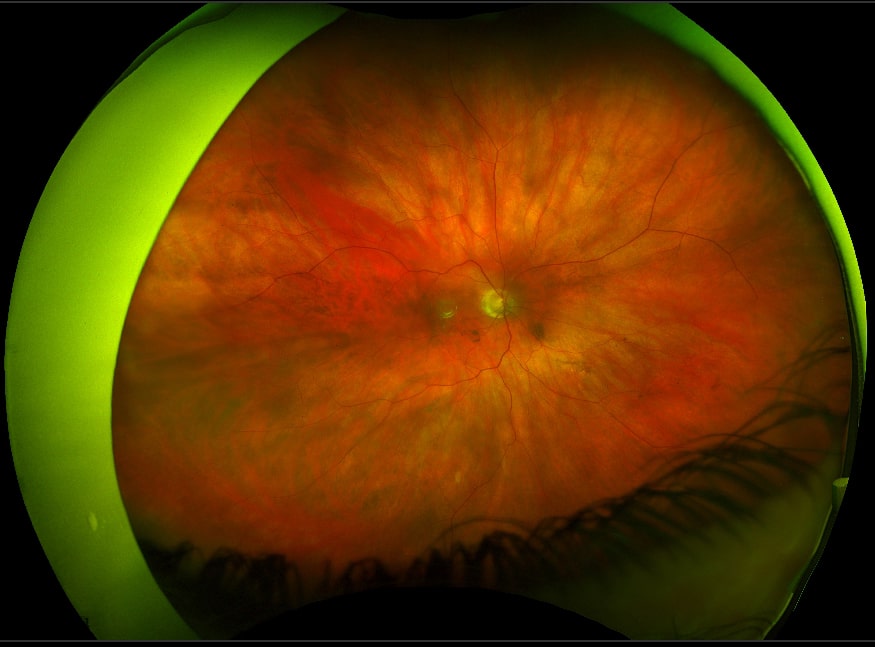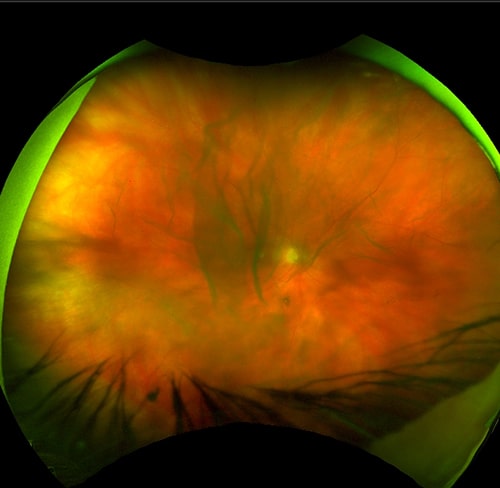Flashes & Floaters
Flashes and floaters can start very suddenly. Floaters usually begin as opacities in the vision, often described as a multitude of little specks (like pepper or dust) or larger opacities (like cobwebs or hair). Flashing lights may precede or accompany these new floaters and are seen as arcs of light in the far peripheral vision, noticed mostly in the dark.
Causes & Symptoms

Floaters may be a single large opacity as in the Weiss ring shown above.

Or floaters may be more dense and widely distributed throughout the gel.
For most patients, PVD formation is a concerning but harmless process that does not threaten vision. In some cases, the vitreous gel can become firmly attached to certain areas of the retina. As it separates, the pull can be strong enough to cause a retinal tear. If left untreated, a retinal tear can lead to retinal detachment. Once a detachment occurs, patients may notice a shadow in their peripheral vision, which can gradually expand to affect their entire field of vision if not addressed. Since new floaters or flashes of light can signal either an uncomplicated posterior vitreous detachment (PVD) or a more serious retinal tear or detachment, it’s essential to seek medical attention promptly. If you’re experiencing new floaters or flashes of light, please contact our office right away.
Other causes of new floaters are bleeding inside the eye (vitreous hemorrhage) or inflammation in the eye (uveitis). The only way to distinguish among the causes of floaters is a comprehensive dilated eye exam.
Treatment
In most cases, floaters associated with PVD, which occurs as part of the natural breakdown of the vitreous gel, are mild and tend to resolve on their own within a few months. However, in some instances, the floaters may be large and persistent. If these floaters significantly interfere with daily activities or vision, surgical intervention can be a highly effective treatment option.
Surgery
Surgery for vitreous floaters is performed by our surgeons with a minimally invasive sutureless system on an outpatient basis. Surgery has an almost 100% success rate of removing the visually significant floaters, and they rarely recur. A few small floaters may remain after surgery, though they do not typically affect the vision. Though the risks of the surgery are generally low, there is still a small risk of vision-threatening complications. For this reason, it's crucial to have an in-depth discussion with your surgeon before considering vitrectomy. Your surgeon may also suggest a period of observation to assess how much the floaters impact your daily life before proceeding with surgery.
Post-Surgery
Recovery from small-gauge vitrectomy surgery is typically quick and painless. Most patients experience blurry vision for the first few days, which usually improves to normal levels within a week. In some cases, the surgeon may place an air or gas bubble in the eye at the end of the procedure, which can temporarily obstruct vision for a few days to up to two weeks. This bubble will naturally dissolve on its own, and there are NO special positioning requirements (such as needing to stay face-down) following surgery. Patients will use eye drops for about one month, and light activity will be recommended for 1-2 weeks. Most non-physical work can typically be resumed within a few days after the surgery.
Schedule a Consultation for Eye Flashes & Floaters
Floaters are a common visual symptom that can result from a range of underlying conditions, from benign to vision-threatening. If they appear suddenly, are accompanied by flashes of light, or are associated with a decrease in vision, it’s important to seek urgent evaluation. If floaters persist and negatively affect a patient’s quality of life, they can be treated effectively with minimally invasive surgery. Request an appointment today at one of our retina centers in Hagerstown, MD, Frederick, MD, Chambersburg, PA, or Bedford, PA.

